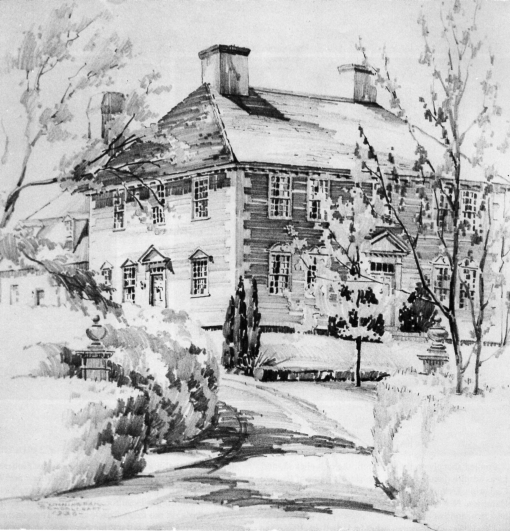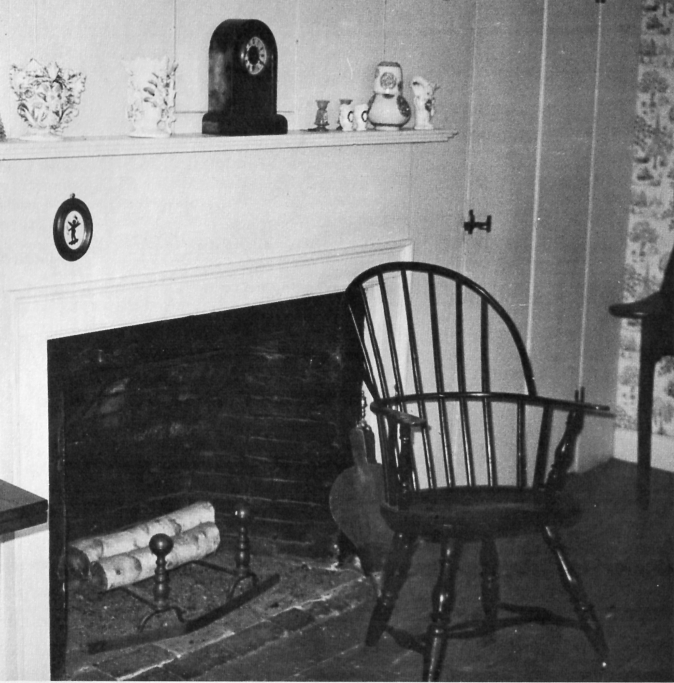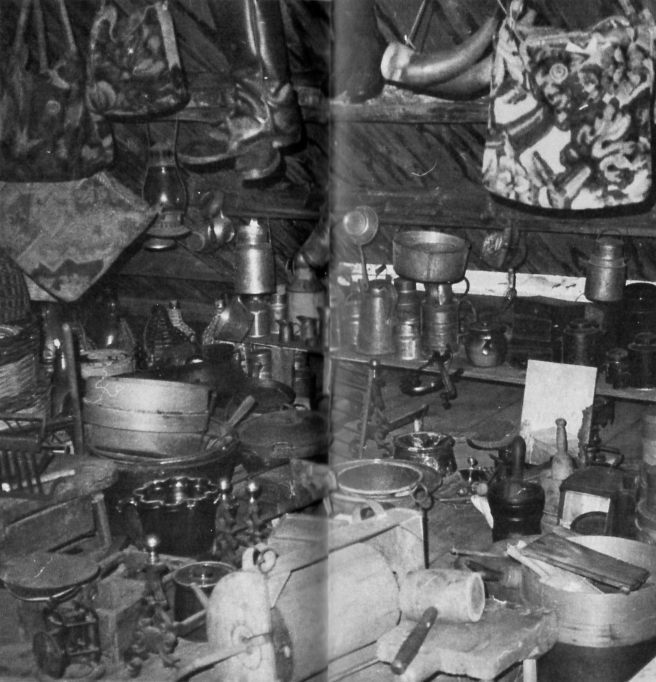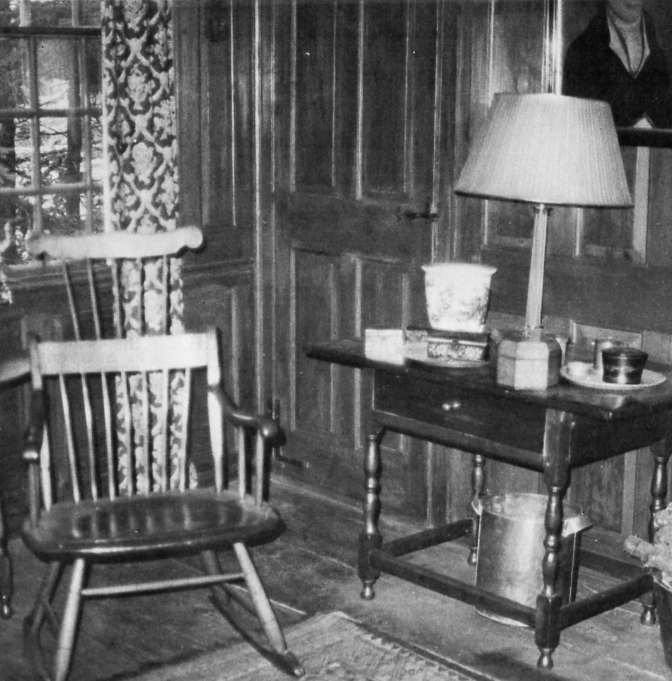A Chronicle of Many Lives
By Judith A. Marden, ’66
The Bates College Bulletin, Alumnus Issue, April 1976.

1936 sketch of the General Moulton house by Cornelia Cunningham Huffer
On the night of April 2, 1975, the trees were bent almost double before the gusting wind; as dry leaves whisked across the lawn, they were caught in the overgrown forsythia bushes. A blizzard with gale winds was forecast for the next day, the clouds around the moon were growing thicker, and the venerable old house seemed to be saying, “If you can’t open that door, you don’t deserve to live here!”
I pulled sharply on  d latch, the bolt clicked, and I was admitted once again to the historic home of the late Catherine Little, ’08: The General Moulton House in Hampton. New Hampshire. It was to be my home for the next two months.
d latch, the bolt clicked, and I was admitted once again to the historic home of the late Catherine Little, ’08: The General Moulton House in Hampton. New Hampshire. It was to be my home for the next two months.
The Littles — Catherine, who had died in 1974, her sister Sarah, ’10. who died in 1963, and their brother Harland, a Princeton graduate who died in 1959 — had been working on the house since the 1920’s. They restored, redecorated, landscaped and furnished, with the intention that the house and its collection of antiques go to the Society for the Preservation of New England Antiquities as a house museum. The Society felt it necessary to refuse the bequest, however, and Bates, as the contingent beneficiary, fell heir to the house and its contents. My job was to act as caretaker. inventory the antiques, and arrange for their move to the College.
Everything in the house, as I entered it on that stormy night, was as though Catherine Little had just left. Her spirit, and those of her brother and sister, were three more added to a long series of inhabitants who had left a mark and a part of themselves just out of sight where the stairs curve up to the attic, or in the old bake oven, or under the paneling.
The first inhabitant, and the builder, was General Jonathan Moulton, an early Hampton settler and a renowned Indian fighter. Moulton was reported to have traded his soul to the Devil for a bootful of gold, to be paid regularly on the first of each month. The general, trying to outfox Satan, cut out his boot sole, so that the next month as the Devil poured the gold down the chimney and into Moulton’s boot set on the hearth, the coins flowed through the sole and filled the room. Satan never easily fooled, investigated, flew into a rage. and burned the house, thus causing General Moulton to build the now existing house in 1769. *[Daily Lynn Evening Item. October 30, 1929.] At any rate, the Boston Chronicle of March 20, 1769, informs us that “Last Wednesday morning, about four o’clock, the large mansion of Colonel Jonathan Moulton of Hampton . . . was wholly consumed by fire. This melancholy accident, it is supposed, was occasioned by a beam taking fire under the hearth in his parlor.”
General Moulton’s wife of twenty-six years died in the new house in 1775, some say of smallpox. *[History of Hampton, N.H., 1638-1892, Joseph Dow, p. 980.] Others, including John Greenleaf Whittier in his poem. “The New Wife and The Old,’ say the General had a hand in it. The story is told that Abigail Moulton no longer pleased her husband and, when she became ill, General Moulton sent for her friend, Sarah Emery, to nurse her. While Sarah looked after Abigail, Jonathan looked after Sarah, to the scandal of Hampton. Abigail died, and the practical General removed all the rings and bracelets he had given to her, and gave them to Sarah, whom he married less than a year later. *[New Hampshire Profiles, “Satan and Abigail’s Ghost,” Alton Hall Blackington, April 1961, p. 45.]
One night, as the couple slept in the “Blue Chamber”:
God have mercy! — Icy cold
Spectral hands her own enfold
Drawing silently from them
Love’s fair gifts of gold and gem.
“Waken! Save me!” Still as death
At her side he slumbereth,
Ring and bracelet all are gone.
And that ice-cold hand withdrawn;
But she hears a murmur low,
Full of sweetness, full of woe;
Half a sigh and half a moan:
“Fear not! Give the dead her own!”
* [“The New Wife and The Old,” John Greenleaf Whittier.]
Others her inauspicious beginning as Mrs. Moulton, Sarah outlived the General, remarried, and moved away. The old General, though, must have stayed with the house, for in 1888, John Greenleaf Whittier wrote: “It was said that he haunted the old house, and used to tramp up and down stairs in his military boots. Parson Milton of Newbury was sent for to lay him”. *[Country Life, “Hampton House,” Alice Van Leer Carrick, 1929 (draft copy) They cornered the ghost in a cellar closet, which they bolted up with heavy planks. *[Blackington, p. 45.]
James Leavitt, from another early Hampton family, next took over the property and kept a tavern and a post office there. He died in 1839, and in 1843, Jabez Towle bought the house. *[Dow, pp. 814, 1013, 834.]
The Towle purchase was the beginning of a long line of connections with the well-known Moulton-Towle silversmiths. The Littles were able to collect several graceful examples of Moulton and Towle flatware. As late as 1894, when Joseph Dow wrote his definitive History of the Town of Hampton , Elizabeth Towle Mace lived in the house with her daughters.
A Newburyport paper of the early 1900’s carried a story of a local man moving back to that city after having lived for some time in the haunted house at Hampton. He moved because he had bad luck all the time he lived there. *[Newburyport Daily News, March 24, 1937.] For a number of years thereafter, the old Moulton mansion stood deserted and unpainted, close enough to Lafayette Road to cause a visual traffic hazard to the increasing number of motorists rounding “Haunted House Curve,”
In 1920, when Harland Little was an employee of A.E. Little Shoe Company, and Catherine and Sarah were teaching in Salem, Massachusetts, they discovered the house and resolved to restore it. First, they separated the main house and the ell which had originally been an older, separate building. Then, it is reported. both structures were hauled back by Italian laborers to a new foundation on the knoll several hundred feet from the road, where the reassembled house now stands. (I am convinced that General Moulton’s ghost still remains walled up in a closet in the old cellar — somewhere under Route 1 — and that’s why he didn’t come out to make my acquaintance while I lived there.)
The Littles began an extensive program of landscaping, painting, wallpapering, and furnishing. The daily journals of Sarah and Catherine describe the careful selection of colors and wallpaper that turned the house into a facsimile of the typical Colonial showplace of the nineteen thirties and forties, Although purists would not approve of the paneling in the pine room (taken from an old house in Newbury and cut to fit), the room became a warm library for the Littles, and an effective setting for the many old leather-bound books they bought for the new bookshelves. The room was a frame for the two tavern tables and Windsor chairs that harmonized with the red-brown stained wood, In other rooms, they covered the original gray-greens and mustard-browns with brighter whites and creams, but left uncovered patches of the first paints for those to whom authenticity meant more than fashion, They were creating a picture: a house to be photographed for New Hampshire Profiles in the style of the times. “Colonial” meant white paint and imported wallpaper, even though the original Georgian structure was built with dark, painted panels and whitewashed plaster.
The collection of furniture and old housewares continued to grow as the house was decorated. Much of the collection reached the attic — there to be organized by classification: cobblers’ equipment, textile devices. tinware, iron, crockery, costumes, for the future museum. The downstairs furniture, of varying quality, at length completed the scene. Original antiques stood beside married and repaired pieces, along with faithful reproductions and modern approximations of a style.
More than an aarchaeologists dream of a preserved 1769 artifact, the Littles’ house is rather the chronicle of many lives, From mansion to post office/tavern, to haunted house and colonial showplace, the rugged old house has survived and withstood changes that might have eclipsed a weaker building. The paneled fireplace walls in the upstairs bedrooms remain the same: the box locks and H-hinges are so numerous as to seem commonplace. The wide floorboards can support many more years of ball-and-claw feet and Bokhara carpets.
The General Moulton House will continue to be an historic landmark in the town of Hampton. Bates College and the Society for the Preservation of New England Antiquities attached a number of preservation restrictions to the deed, to ensure that future owners will maintain the architectural integrity of the house. Even though the Littles’ original plans necessarily have been changed, their furniture and housewares will form the nucleus of a fine college teaching collection, and their handsome Georgian house will be preserved for its architectural merit and its prominence in local legend.
In her newly-created job as Liaison Officer for College Functions, such as Commencement and Parents Weekend, Judith Marden’s first duty was to supervise the transportation of the Little antiques from Hampton to the Bates campus. Prior to her present position. she was Development Officer and Acting Director of Development. C. Walsh Movers of Boston assigned their top packers to the project — the same men who handle the priceless collections of the Boston Museum of Fine Arts. In a week’s time the entire contents of the house had been packed, moved, and unloaded at Bates. The antiquities are being catalogued and organized. and the Moulton House is in the hands of a realtor.


